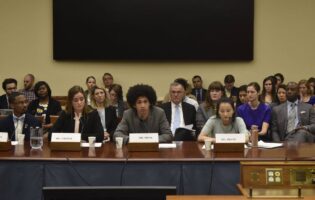
Bridging Academic and Occupational Learning and Credentialing: Crossover Competency-oriented Program Shaping in U.S. Postsecondary Education

Volker Rein
Volker Rein is a DAAD/AICGS Research Fellow in October to December 2018. He is an experienced social scientist specialized on developments in education and training systems and policy as well as on skills requirements in Germany, in Europe, and in the U.S. He is working as a senior research associate in the Department of Learning and Teaching at the Federal Institute for Vocational Education and Training (BIBB) in Bonn, Germany. He has long-term experiences in research and development work as well as in advisory work on competence-oriented qualification standards and transparency instruments (qualifications frameworks, recognition of prior learning, credit transfer, etc.) in Germany and in the European Union since 1999. He was involved in the implementation of the European Degree Framework at University level (Free University Berlin) and in the development of the European and the German Qualifications Frameworks for Lifelong Learning in terms of formal, non-formal, and informal learning outcomes. He currently contributes to UNESCO’s development of World Reference Levels to connect qualifications frameworks globally. In this field, his special focus in R & D is on the compatibility potential between Vocational and Higher Education in terms of competency and proficiency. In the U.S., he contributed his expertise to the development of a nationwide Credentials Framework that addresses both degree and non-degree credentials in 2013-15 in terms of the general construction. He holds a Ph.D. and an M.A. in Social Sciences (Free University Berlin) based on field research in Southern Africa.
In the U.S. as in Germany, a debate drives shaping programs and credentials in all education and training sectors along competencies to address the needs of the societies, labor markets, and learners to promote lifelong learning and the transferability of learning achievements between the education pathways. The increasingly knowledge-based requirements in manufacturing and service areas and the trend to academic education of the advanced skilled workforce require appropriate systemic, instrumental, and conceptual adaptations in postsecondary education and training. In his research at AICGS, Volker Rein assumes that a fundamental dichotomy between academic and occupational requirements does not exist per se. On the contrary, in both educational approaches there is a potential compatible practice orientation for an acquisition of appropriate knowledge, skills, and competencies to solve complex problems and tasks. Using a comparative bi-national perspective, this research on relevant developments in U.S. postsecondary education and training will focus on community colleges. It intends to generate new theoretical and empirical findings regarding competency-related approaches at associate and bachelor levels in degree and non-degree programs, which try to address academic and professional requirements in a compatible and integrated way. This represents a considerable prerequisite for the development of compatible credentials in degree and non-degree education in terms of connectivity, progression, and employability.
Research insights on approaches, challenges, and perspectives
The Problem and Relevant Developments in the U.S. and in Germany
Since the 1980s, American, German, and European experts and major stakeholders in politics, educational practice, research, and economics have been discussing the increasing demand for a competency-oriented shift to learning outcomes in shaping education programs and qualifications in postsecondary education at all levels.[1]
The debate in academic Higher Education (HE) and Technical Education (TE) including Vocational Education and Training (VET) about competency-oriented postsecondary education and training is taking place in the context of increasingly knowledge-intensive requirements for a skilled technical and management labor force in the major professional fields of production as well as in primary and secondary service areas. Furthermore, this debate is connected to a need for corresponding sustainable reforms in educational concepts to shape programs and credentials in appropriate ways across institutional systems and cultures.[2]
Since the 1990s, education and training experts in both countries have been discussing the ongoing problem of curriculum compatibility between academic and technical education, particularly the lack of overarching design requirements for curricula, for teaching and assessment, as well as for articulation and transfer agreements toward the bachelor track.[3] Universities have predominantly provided discipline-specific and knowledge-based competency achievement, while TE has focused on action-oriented capability in functions, tasks, and processes. Both education sectors articulate in their different ways the comprehension of practice as a central reference point in education and training and in the design of qualifications. However, the intersections of relevant competency approaches used in HE and TE have not yet sufficiently discussed developing concepts for compatible competency-oriented qualifications to promote their connectivity and permeability across the education sectors.
The European Union agreed on the comprehensive shift to competency-oriented learning outcomes as the major paradigm of qualification development both in HE and in VET. In line with this policy, the German government developed and implemented National Qualifications Frameworks for academic degrees in 2005 along the Bologna agreements for European Higher Education and for Lifelong Learning in 2011 to facilitate the transparency, transferability, and quality of qualifications within and between the education sectors.[4]
Two major conceptual developments influence the qualification design at the interface of HE and VET in Germany. First, an increasing number of so-called dual study programs try to integrate in variations of HE and VET predominantly in bachelor (BA) programs, in part in cooperation with enterprises. Second, the German government supports the R&D program NEXUS to provide a qualification development concept which facilitates addressing professional requirements and competencies of academic graduates.[5] With the exception of some advanced BA and MA programs the curricula, however, do not yet synthesize the theoretical and the practical learning phases in complementary formats.
For a long time, U.S. education politics have been determined by ongoing debates concerning deficits in academic education and workforce development. The federal government has made increased degree and credential completion in postsecondary education a national priority to be accomplished at a community college or a four-year college as well as via vocational training, apprenticeship, or industry certification. It stressed that U.S. postsecondary education urgently needs quality improvements to meet competitive workforce requirements.[6]
Meanwhile, competency-based education is the guiding principle of program development in U.S. education enforced by state standards or by federal regulations. In 2013, more than 80 percent of all colleges and universities adopted stated learning outcomes for all their undergraduate programs. And the demand is increasing, predominantly driven by accreditation agencies to promote in particular the policy objectives of program accountability and employability of graduates.[7]
The Degree Qualifications Profile (DQP) framework for U.S. academic higher education developed by the Lumina Foundation for Education in 2014 tries to define educational quality in terms of student learning and learning outcomes along proficiencies.[8] The foundation later released a sector-overarching U.S.-wide Credentials Framework (CF) for lifelong learning to promote the transparency and the comparability of credentials as well as their portability across institutions along competencies. This approach tries to address both degrees as well as non-credit credentials like certificates, industry certifications, licenses, apprenticeships, and badges.[9]
Research Approach
From a comparative perspective on relevant developments in the U.S. and Germany, this research intended to generate new empirical findings and theoretical insights regarding competency-related approaches in U.S. postsecondary education and training at the associate level and neighboring requirement levels, which tries to address academic and professional requirements in a compatible and integrated way.[10] This concerns further considerations for a theory-practice linked design of credentials; the development of profiles, curricula, and assessment of programs; as well as articulation regulations between degree programs and between academic and non-degree learning to promote progression and the employability of learners.
As academic entry qualifications, associate degree programs play a key role in U.S. postsecondary education, linking academic-oriented and occupation-oriented learning as well as degree and non-degree learning. Work-based learning can be recognized in associate programs via dual enrollment regulations and associate programs can be embedded in bachelor programs via dual admission arrangements to facilitate academic progression.
The research concentrated on regular associate programs and associate programs with links to apprenticeship, to certificate programs, and to bachelor programs. The objects of the research were analyzed on the reference levels education research and development concepts, requirement areas, and institutional regulations and practices with specific focus on selected programs in business administration and information technology.
In a preceding theoretical and empirical research on German bachelor and master programs, comprehensive professional-scientific competencies could be identified in the following requirement areas: knowledge and understanding, learning, identification and solution of problems, reflectivity and judgment, self-organization and planning, selection and application of methods, decision-making, responsibility and leadership, communication, and transfer.[11]
The following findings are discussed along guiding research questions as summarized essentials of interviews, discussions with education experts, and the analysis of programs and other relevant documents at five community colleges in four U.S. states. The research focused on community colleges that were either involved in the U.S. TUNING program of the National Institute of Learning Outcome Assessment (NILOA) or in the Right Signals Program of the American Association of Community Colleges (AACC). In addition, numerous interviews and discussions were carried out with education researchers at several universities and with education experts at several major associations and institutions involved in education policy.
Essential Research Findings
Which competency-oriented conceptual approaches to addressing both academic and occupational requirements in a complementary way are applied in associate programs? What is the predominant referential basis of these approaches?
Based on the key learning dimensions of knowledge, skills, and attitudes in U.S. education and training, the selected community colleges apply more than one conceptual approach to classify and describe comprehensive competency learning outcomes in associate program development and related procedures (e.g., examinations, recognition of prior learning ).
For this purpose, they traditionally use the updated version of Bloom’s taxonomy of educational objectives and variations of key competencies and major specific core competencies provided by manuals or guidelines for program development.[12] Some community colleges require the acquisition of key competencies (e.g., in communication, problem solving, social responsibility, and independent learning), especially in program capstone courses.
In recent years the selected community colleges use the schematic of the reference instruments Degree Qualifications Profile (DQP) and Credential Framework for Lifelong Learning (CF) to describe learning outcomes in terms of knowledge and skills. In addition, the DQP includes the learning dimension. The DQP uses proficiency as its overarching term which to a high degree matches a comprehensive understanding of competency, the key term of the CF. The colleges use the comprehensive CF descriptors to an increasing extent. Furthermore, the colleges use the job descriptions of Occupation Network[13] as a labor market reference tool as well. Further elaborated theoretical models to describe occupational and academic learning outcomes in a comprehensive way have not yet been developed or applied at the colleges.
The colleges predominantly carry out program development based on research along the DACUM (Developing a Curriculum) methodology and involve faculty members and experts from cooperating four-year colleges and industries. The accreditation agencies expect the degree programs to be designed along competency-oriented learning outcomes but do not specify further detailed requirements in this respect.
Do these competency-oriented learning outcomes defined in the programs address both requirements in assessment (curricula and examinations) and articulation procedures in the professional domain (work) and in the public domain (e.g., civic engagement)?
Academic-occupational bridges by recognition of prior learning have long been possible. But less than 50 percent of the associate program credits can be covered by documented learning achievements of non-degree programs (e.g., certificates, apprenticeships). The applied equivalency matching methods are competency oriented but not in a systematized way based on one of the approaches discussed in the previous section. The ACE Credit matching system for non-degree learning achievements has been implemented nation-wide since 1974 but does not systematically match competency-oriented design based on recent approaches.[14]
Some community colleges developed an associate program design guideline based on the test results of the CF cross-over descriptors for learning outcomes. Although they developed guidelines for major core competencies together with experts from four-year colleges, these guidelines have not yet been accepted by those colleges in terms of articulation purposes. Some of the four-year colleges developed and use their own handbooks for Career Readiness Competencies (e.g., critical thinking), for Key Competencies (e.g., analytical reasoning), Major Core Competencies (e.g., for sciences), as well as for learning outcomes for non-academic practice (e.g., in business administration and engineering). These handbooks are used for both program and articulation purposes.
In the U.S., an education for civic capabilities and engagement is based on a long tradition. At the selected community colleges, civics is predominantly linked to key competencies and implicitly directed to be applied both in the public and in the professional domain. College practitioners from both two-year and four-year colleges demanded a better linkage to major courses and an improved promotion by appropriate pedagogic methods and adjusted practice.
Do the identified professional-scientific requirement and competency areas defined in Germany provide an appropriate orientation for program development and articulation purposes?[15]
Both education experts from the selected community colleges, four-year colleges, universities, and research institutions confirmed a big intersection of the professional-scientific requirement and competency areas (PSRC) with existing and applied key competencies in the U.S. as well as its relevance for academic-occupational education program design and articulation. Furthermore, they suggested elaborating on the PSRC in a more specified way concerning qualification areas and levels for application purposes.
Which other competency-oriented conceptual approaches are discussed to address both academic and occupational requirements in a complementary way?
-
CCRC: Guided Pathways
The Community College Research Center (CCRC) at the Teachers College at Columbia University initiated and coordinates the Guided Pathways program to increase the associate degree completion achievement nationwide. An essential element of this concept is mapping programs via Meta Majors based, for example, on core competency-oriented learning outcomes. The cross-over descriptors of the Credentials Framework are used as one conceptual reference basis of the Meta Majors. This methodological approach safeguards a better conceptual connectivity of credentials within one program and toward other degree and non-degree programs and promote bridges between learning inside and outside classrooms. The Meta Majors are developed in cooperation with experts on non-degree credentials like industry certifications and four-year college experts on bachelor and graduate programs. More than 250 community colleges in numerous states participate in Guided Pathways.[16]
-
AACU: Essential Learning Outcomes
Launched in 2005 by the Association of American Colleges & Universities (AACU), Liberal Education and America’s Promise (LEAP) responds to the ongoing demand both for a more college-educated workforce and for more engaged and informed citizens. This program assumes that college graduates need higher levels of learning and knowledge as well as stronger intellectual and practical skills to navigate successfully and responsibly in a more demanding economic and societal environment. For this comprehensive purpose LEAP developed the Essential Learning Outcomes (ELO) as a guiding vision and practical approach to college learning as a cumulative process. These competencies are described in a detailed manner in the rubrics Intellectual and Practical Skills, Personal and Social Responsibility, and Integrative and Applied Learning. These rubrics had been taken into account in the development of the DQP structure and the defined ELO and have strong intersections with similar defined catalogues of key competencies, such as those used at community colleges.[17]
-
NILOA: Learning System Paradigm
The National Institute of Learning Outcome Assessment (NILOA), affiliated with the University of Illinois at Urbana-Champaign, comprehends appropriately-defined learning outcomes as an essential factor for successful learning in a comprehensive sense, which is relevant beyond curricula development for examinations, recognition of prior learning, accountability, etc. The Institute developed the Learning System Paradigm, which combines the Shift from Teacher to Learner and the Constructive Alignment of curricula development, didactics, and assessment as essential conceptual prerequisites.[18]
The paradigm requires trust and consensus among all relevant stakeholders, including faculty from different colleges, industry employers, researchers, learners, and an alignment of evidence-learning demonstrated in all learning environments, including non-academic areas. This involves curricular mapping, scaffolding, assignment design, delineation of career pathways, and co-curricular engagement.
In this way, the required competences of prospective academic professionals shall be unpacked and re-defined. To safeguard academic quality and compatibility, the development of interdisciplinary capstone courses across all programs is recommended. NILOA uses as reference tools for its work the learning outcome dimensions and descriptors of the DQP and the related U.S. TUNING methods in terms of reframing academic quality. In addition, the institute applies the Essential Learning Outcomes to address key competencies.
Conclusions and Outlook
What are the current challenges and possible practical and political options for a competency-oriented shaping of degrees and other postsecondary credentials in terms of bridging professional-academic requirements?
Similar to the European Union, the shift to competency-oriented programs in U.S. postsecondary education institutions is an enduring work in progress. This includes any development to conceptually bridge occupational and academic learning as well. There are strong concerns that current institutional autonomy, quality, and perspectives might be weakened by this approach.
However, it is more and more evident that a conceptual dichotomy does not exist per se for the design of education and training programs and credentials addressing both academic and professional requirements in a compatible way. Based on cross-over, subject-related, and social and personal competencies, there is an implicit common competency-oriented potential to act and to apply learning outcomes in specific learning or work contexts to solve complex problems.[19]
An increasing trend to “bridge” occupational and academic learning practically in many ways is evident. This does not take place on a basis of one conceptual approach for a compatible program development the education stakeholders might have agreed on. As in the EU, a cross-over understanding of academic and occupational learning has not yet been generated and operationalized at a large scale for program design in U.S. post-secondary education sectors. All discussed instrumental approaches share a common conceptual intersection and this provides sufficient stimuli for further considerations.
The application of overarching key competencies and core competencies of majors as they are already facilitated by manuals and guidelines in college might promote such developments in future in all program areas and institution-wide. This also supports learning and teaching of civic engagement capabilities being relevant for both public and professional domains. Furthermore, the translation of descriptors of comprehensive reference instruments like the DQP and the Credentials Framework to program area specific requirements may support this development as well, as it has been promoted by U.S. TUNING and Connecting Credentials initiatives. Implemented in many associate programs, capstone courses are appropriate to enforce comprehensive occupational-academic learning outcomes.
The traditional challenge between the academic perspective and workforce development perspective might be reduced and even overcome if program developments are carried out based on appropriate research approaches more than before. This should take into account both empirically analyzed work requirements and already existing relevant (inter)disciplinary knowledge and perspectives as well, which could also be in the interest of industries. It is assumed that research-generated knowledge and work experience-generated knowledge can be competency-oriented and level-oriented in postsecondary education and training programs.
The proposed measures can be dead ends if they are not implemented institution-wide in terms of horizontal and vertical credential connectivity. This requires not only an IT based matching of course equivalencies, but adjusting conceptually program developments that try to link degree and non-degree learning in a systematic way. Standardized requirements of general education outcomes and better linking them to other majors of any associate program are other options recommended by education experts. Finally, the ongoing shift of the traditional input-driven U.S. credit transfer system to an outcome and competency-oriented practice supports sustainably bridging academic and occupational learning starting at secondary education and across postsecondary education. This has not yet been achieved in EU education and training systems.
The demand for a dramatic increase of postsecondary credentials access has long been shared by the U.S. federal and state governments and by other major stakeholders like business employers, research institutions, and foundations to address urgent societal and economic needs in the U.S. Competency-oriented programs and seamless credential pathways are regarded as important measures to achieve this objective.
Furthermore, a competency-oriented bridging of academic and occupational learning has the potential to overcome cultural mindsets at system level (college vs. non-college education), at institution level (two-year vs. four-year college), and at discipline level (technical sciences vs. liberal arts), by a common language and understanding of key terms like knowledge, practice, and work.
Competency orientation understood across the sectors as a comprehensive concept might also have the potential to reinforce a broad concept of education beyond a pure utilitarian perspective, which is traditionally shared by the U.S. and the EU.
Supported by the DAAD with funds from the Federal Foreign Office (FF).
[1] Cf. Jens Bjornavold, The shift to learning outcomes (Thessalonica, 2008).
[2] Cf. Thomas R. Bailey and Yukari Matsuzuka, Integration of vocational and academic curricula (Washington, DC: NSF Advanced Technological Education Program, 2003).
[3] Cf. W. Norton Grubb and Cathy Stasz, “Integrating academic and vocational education.
Progress under the Carl Perkins Amendments of 1990.,” U.S. Department of Education, National Center for Research in Vocational Education, for the national Assessment of Vocational Education, 1993.
[4] Cf. Bundesministerium für Bildung und Forschung, Kultusministerkonferenz & Arbeitskreis Deutscher Qualifikationsrahmen, Deutscher Qualifikationsrahmen für lebenslanges Lernen (Berlin: Author, 2011).
[5] Cf. Hochschulrektorenkonferenz – HRK, Wissen und Können. Kompetenzziele, Lernergebnisse und Prüfungen studienzentriert formulieren und gestalten (Bonn: Author, 2013).
[6] Barack Obama, “Remarks of President Obama, Address to Joint Session of Congress,” The White House, February 24, 2009.
[7] Cf. Natasha Jankowski and David Marshall, Degrees that matter. Moving Higher Education to a learning system paradigm (Sterling, VA: Stylus Publishing, LLC, 2018).
[8] Degree Qualifications Profile (Indianapolis, IN: Lumina Foundation, 2014).
[9] Cf Volker Rein, “Making an American Credentials Framework. Intentions, Construction, Challenges and Perspectives,” 2016.
[10] Volker Rein and Shyamal Majumdar, “TVET and academic Education. A blurring distinction – new opportunities for the future,” in Crisis in Education, ed. N. Papadakis & P. Kalogiannakis (Athens, 2018).
[11] Volker Rein, “Towards the compatibility of professional and scientific learning outcomes: Insights and options in the context of competence orientation,” International Journal for Research in Vocational Education and Training (IJRVET), Vol. 4, Issue 4, December 2017, 325-345.
[12] Lorin W. Anderson and David R. Krathwohl, eds., A taxonomy of learning, teaching and assessing. A revision of Bloom’s taxonomy of educational objectives (Boston, MA: Allyn & Bacon, 2001).
[13] O*NET OnLine is sponsored by the U.S. Department of Labor, Employment & Training Administration.
[14] Cf. American Council of Education, American Council on Education’s College Credit Recommendation Service, 1974.
[15] Volker Rein, “Towards the compatibility of professional and scientific learning outcomes: Insights and options in the context of competence orientation,” International Journal for Research in Vocational Education and Training (IJRVET), Vol. 4, Issue 4, December 2017, 325-345.
[16] Cf. Davis Jenkins, Hana Lahr, and John Fink, Implementing guided pathways: Early insights from AACC pathways colleges (New York, NY: Columbia University, Teachers College, Community College Research Center, 2017).
[17] Cf. American Association for Colleges and Universities, Essential Learning Outcomes, 2005.
[18] Cf. Natasha Jankowski and David Marshall, Degrees that matter. Moving Higher Education to a learning system paradigm (Sterling, VA: Stylus Publishing, LLC, 2018).
[19] Cf. Volker Rein and Shayamal Majumdar, “TVET and academic Education. A blurring distinction – new opportunities for the future,” in Crisis in Education, ed. N. Papadakis & P. Kalogiannakis (Athens, 2018).









